Heavy tank T-35
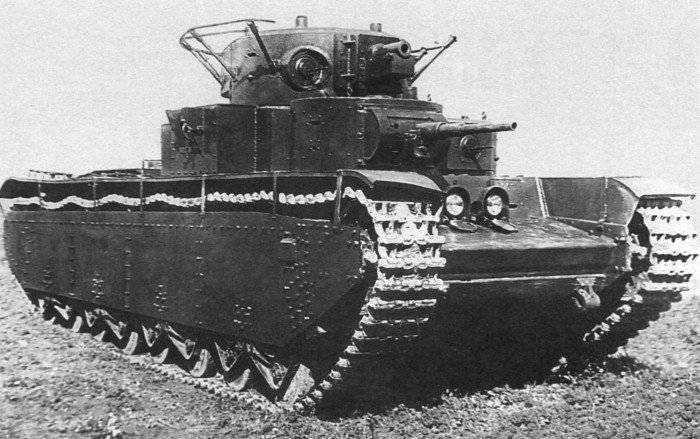
Development and production
Work on a heavy tank in the USSR began at the end of the 20-ies, but the lack of the necessary experience in this area among domestic designers did not allow the development of a full-fledged combat vehicle. The way out of this situation was to invite German designers under the leadership of Edward Grotte, who arrived in the Soviet Union in 1930 and, together with young engineers, began to design a heavy tank. And although the TG tank created under the leadership of Grotte did not go into the series, the Soviet designers were able to gain invaluable experience, which was used in the design of domestic heavy combat vehicles.
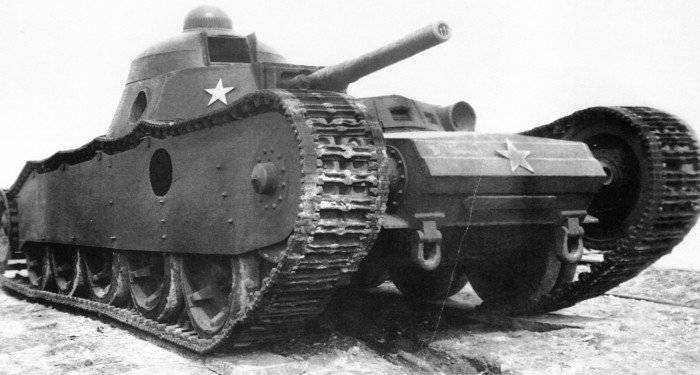
After the work on the TG KB tank, which consisted of Soviet engineers working with Grote, was stopped under the guidance of N. Barykov, they began to develop their own heavy tank. The assignment was issued by the Office of Mechanization and Motorization of the Workers 'and Peasants' Red Army and it said: “By 01.08.1932, develop and build an 35-ton breakout tank of the TG type”. During the design of the T-35, the designers used the one and a half year experience of working on the TG tank, the test results of the German Grostruktor at Kazan and the materials of the commission for the purchase of armored vehicles in the UK.
The assembly of the first prototype, which received the designation T-35-1, ended 20 August 1932, and on September 1 the tank was shown to representatives of the UMM RKKA. The tank's weight was 42 tons, armor thickness — 30 — 40 millimeters; weapons included: one 76-millimeter and two 37-millimeter cannons (instead of 76-mm guns on the T-35-1 the layout was installed) and three machine guns. The crew of the tank consisted 10 — 11 man. Tank dimensions: length 9720 mm; width 3200 mm; height 3430 mm. Power reserve 150 km (on the highway). The 500-powerful M-17 engine allowed the tank to reach speeds of up to 28 kilometers per hour. The ground pressure was less than 0,7 kg / cm². Basic rollers grouped in pairs of three trucks on one side. The top of the main tower had a rounded shape.
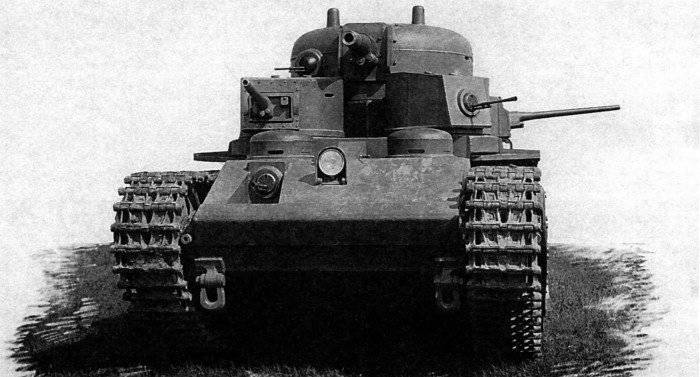
The T-35-1 showed good results during the tests of the 1932 of the past year in the fall and met the military, however, there were several shortcomings in the power plant of the tank. In addition, the design of the pneumatic control and transmission actuators was too complicated and expensive for mass production. The designers proposed to refine the project on the identified deficiencies, to strengthen the armament and also to unify some details (for example, the main bashi) with the medium T-28 tank.
Tank production of the plant "Bolshevik" in February 1933 was allocated in a separate plant number 147 them. KE Voroshilov, while the Barykov Design Bureau was reformed into the OKMO (Experimental Engineering Machine Building Department), which began to refine the T-35-1.
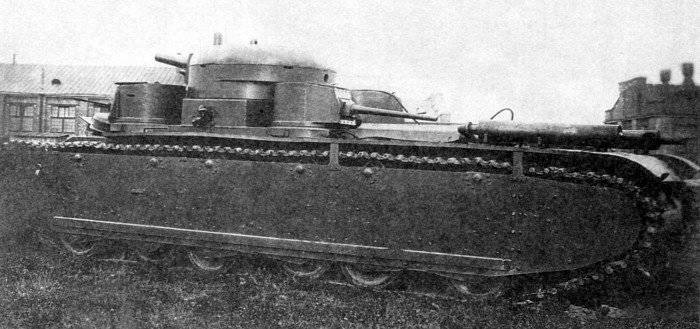
The second sample, designated T-35-2, was assembled in April 1933, and on May 1 it was attracted to participate in a parade on Uritsky Square (former Palace) in Leningrad. The tank was different from the T-35-1, not only the main turret, but also the installation of another engine, the form of a bulwark and some other minor details.
In parallel, the design bureaus in the design bureau of the production tank T-35А. The T-35A tank had significant differences from the T-35-1 (2). The chassis was lengthened by one trolley, small machine-gun turrets had a different design, medium turrets having an enlarged shape were equipped with 45K 20-mm cannons, the hull shape was changed, besides, there were other minor differences. All this caused difficulties in manufacturing, since the T-35A tank was essentially a completely new machine.
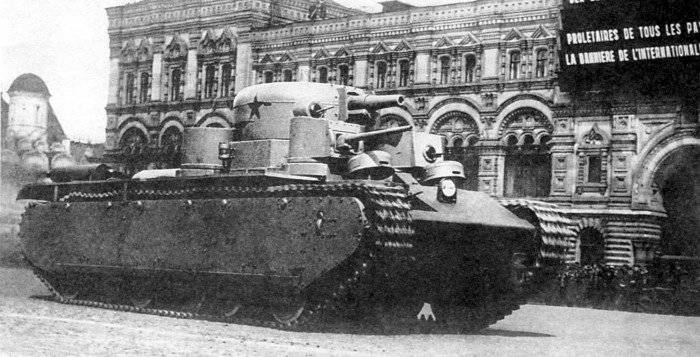
Serial production of the T-35 tank was entrusted to the Kharkov Locomotive Plant to them. Comintern. Work on the improvement of the tank began in 1932, the head of the work was N. V. Tseyts. The 11.08.1933 T-35 was put into service, and with the 1934 the tank began to enter the troops.
In 1933, the 2 serial models were launched, and in 1934 they began small-scale production. In various years, the following number of tanks was launched: 1933 - 2; 1934 - 10; 1935 - 7; 1936 - 15; 1937 - 10; 1938 - 11; 1939 - 6.
In total, the 1933 prototype and the 1939 serial machine were released from 2 to 61 years.
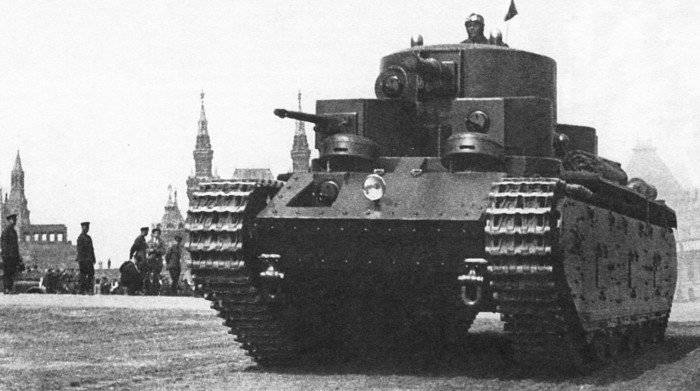
During production, changes were made to the structure many times. For example, in 1937, the thickness of the side, upper and lower front plates was increased, the armor of the towers and the stern was made of 23-mm armor plates; engine power has been increased to 580 l. with.; tank weight increased to 52, and then to 55 tons. The number of crew members is from 9 to 11 people. The last six cars, released in 1938 — 1939, had conical towers, improved hull seals and a modified design of the side screens. Suspension elements were also strengthened.
Tank design
T-35 was a heavy tank of the classic layout, five-turreted, with a two-tier arrangement of guns and machine guns. Reserving a tank was adequate for the time it was created (it should be noted that it was not inferior to most tanks during the initial period of World War II), but it was not enough to accomplish the breakthrough task by the start of the war.
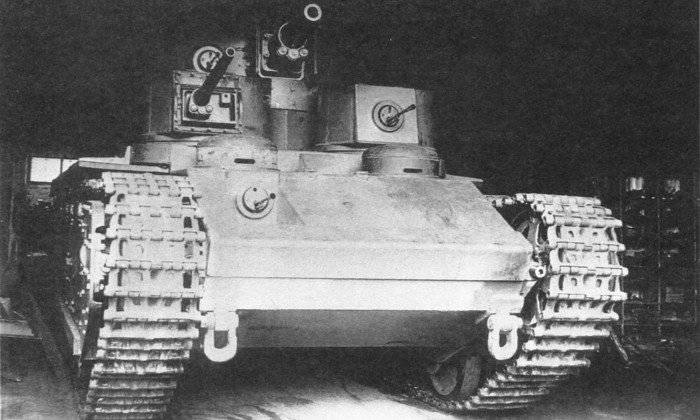
Chassis
The tank had a box-shaped body of complex configuration. The hull was welded (partially riveted) of armor plates of 10 thickness - 50 millimeters. The thickness of the armor of the T-35 tank was mainly millimeters 20 (bottom of the front, side and stern). The towers were made of armor thickness 25 — 30 millimeters. On the left, in the forward part of the hull, there was a driver's access hatch having a viewing slot covered with a glass block. During the march, the hatch could remain open (the opening was made upwards, a screw mechanism was used for fixation). To enter / exit the driver used a roof hatch located above his workplace. Initially, the hatch was made as a double wing, but was later replaced by a single folding one. A later modification of the tank, which has conical towers, had an oval hatch, made similar to the design of the BT-7 turret hatch. The main tower had a six-sided pedestal - the so-called “hexagon”. On its sides were located boxes designed to accommodate smoke curtain making devices. Behind the aft towers, air intake louvers were fitted, which were covered with armored screens, as well as the engine access hatch. The silencer was located behind the hatch. In the top sheet of the stern was made a round hole designed to install the fan. The hole was covered with a removable armored cap having blinds.
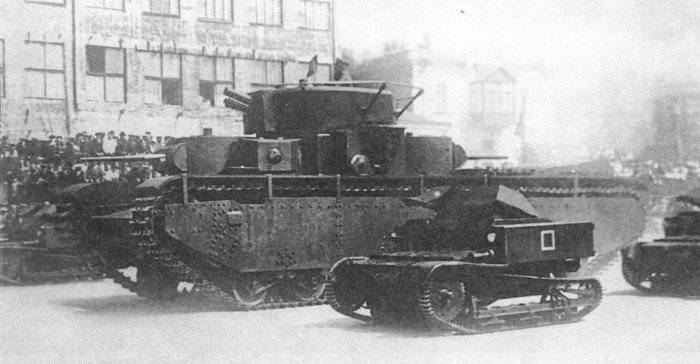
The main tower T-35 and the tower of the T-28 tank of the first releases were identical in design (until the introduction of the conical towers, the main tower did not have a full-time ball mount machine gun). It had a cylindrical shape and a developed feed niche. In the front of the axle mounted 76-millimeter gun, it was located to the right of the machine gun. For the convenience of the crew, the tower was equipped with a suspended floor.
The construction of medium-sized towers is identical to the towers of the BT-5 tank, but without a stern niche. The shape of the towers is cylindrical, with two hatches for crew access. The 45-mm cannon and the machine gun paired with it were mounted in its front part.
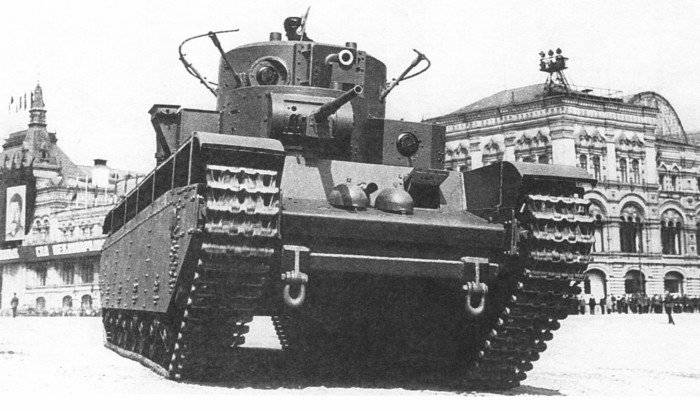
Small machine-gun turrets had the same design as the machine-gun turrets of the T-28 tank, however, unlike them, they were equipped with ring eyes used for dismantling. The cylindrical turrets in the bow had a projection shifted to the right. A DT machine gun in a ball mounting was placed in its front sheet.
The last production T-35 tanks had conical towers, while the design of their main tower was identical to the T-28 turret.
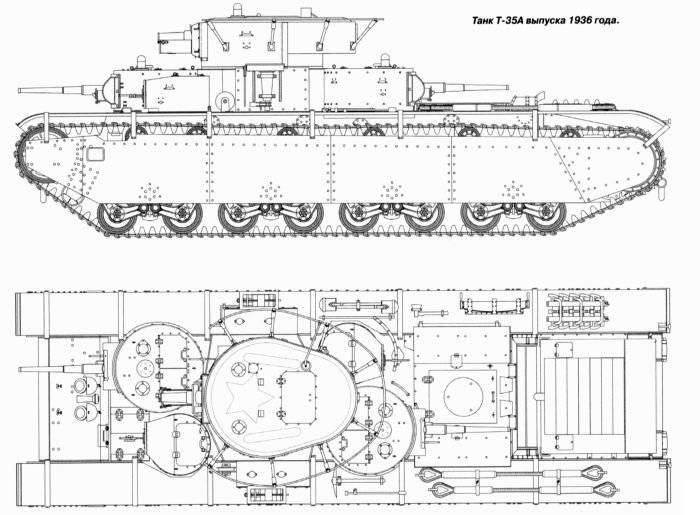
weaponry
Armament T-35 housed in two tiers of five towers. The 76,2-mm KT-28 27 / 32 model cannon was installed in the central turret (it was planned that PS-3 would be installed), which was a tank version of the regimental gun mod. 1927 d. Barrel length 16,5 caliber. The initial speed of the ammunition - 381 meters per second. As sighting devices used tank periscope arr. 1932 and telescopic sight arr. 1930 d. To the right of the gun was mounted a DT machine gun in a ball independent installation. In the tower niche a slot was made for the skid-mounted installation of the second DT machine gun. The slit was closed with a special armored flap. On some tanks, a standard ball mount was used to install the stern machine gun. Also, on the hatch of the tower with the help of the turret was installed another DT used for firing at air targets.
A pair of 45-mm guns 20K arr. 1932 was installed in small cannon turrets, which were located diagonally (right-front and left-rear). The initial velocity of the armor-piercing projectile was 760 m / s. The guns paired with DT machine guns were fixed on the axles in the movable armor. In machine-gun turrets, located diagonally (left-front and right-rear) were used to install DT machine guns.
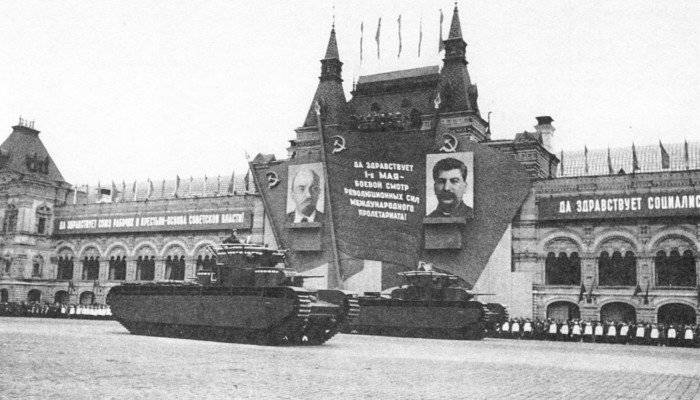
The ammunition consisted of: 96 rounds for the 76-mm gun, 220 rounds for the 45-mm guns and 10 thousand rounds for machine guns.
Thus, the T-35 was armed with approximately one medium tank T-28 and two light tanks T-26.
Engine and transmission
V-shaped twelve-cylinder carburetor engine M-17 with liquid cooling, was installed in the rear of the case. Engine power at 1450 rpm was 500 l. with. This allowed the tank to reach speeds of up to 30 km / h on the highway and around 12 km / h on rough terrain. Fuel tanks with a capacity of 910 liters were provided with a power reserve of up to 150 km along the highway. The engine and manual five-speed gearbox were connected through the main clutch. The turning mechanism served as side clutches with band brakes.
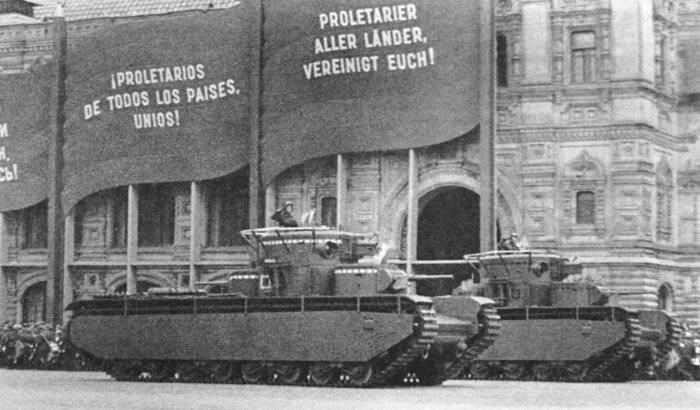
Chassis
Each side of the caterpillar propulsion unit consisted of: eight rubber-coated small-diameter support rollers, six supporting rollers with rubber tires, guide wheels equipped with a screw tension mechanism, driving rear wheels with removable gear rims, open-wheel track chains with open hinges. The tracks were connected by fingers, which were locked with cotter pins. Tension rollers were installed between the front support rollers and the guide wheels, which prevent the front branches of the tracks from sagging during the overcoming of vertical obstacles.
Suspension - blocked, two rollers in the cart; suspension by means of two coil springs. The undercarriage was covered with 10-mm armored screens. The tank was able to climb up to 36 °, a ford 1,2 m deep, vertical walls 1,2 m high, ditches 3,5 m wide. The specific ground pressure was 0,78 kg / cm². The maneuverability of the tank was adversely affected by the large value of the ratio of its length to width (> 3).
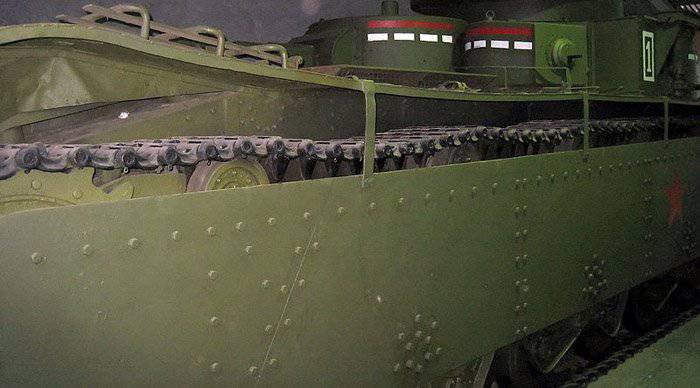
Electric equipment
The tank was equipped with a radio station 71-TK-1, which has a hand-held antenna around the main tower, a telephone intercom for seven subscribers, a smoke suppression system. Electrical equipment was carried out on a single-wire circuit with a voltage network 12В.
Crew accommodation
During production, the number of crew members of the T-35 tank ranged from 9 to 11 people, depending on the design features of a particular series. In most cases, the crew accommodation looked like this. At the top - the main tower, which was unified with the T-28 tower, housed three crew members: a commander (also performing the functions of a gunner), a machine gunner, and a radio operator (also performing the functions of a loader). In the two towers in which 45-millimeter cannons were installed, there were two people each - a machine gunner and a gunner, in a machine-gun towers - one gunner. The main tower from the rest of the combat compartment was fenced off by a partition. The rear and front towers communicated in pairs. Between the tracks, in front of the tank, there was a department of management in which the driver was placed (had limited visibility due to the fact that the tracks of the tracks strongly came forward, often driving the machine almost blindly).
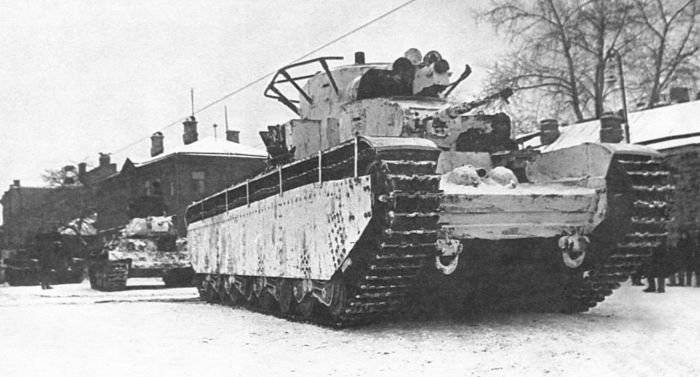
Equipment developed on the basis of the T-35 tank
Tank T-35 as a base was used to create an experimental heavy SAU (self-propelled artillery mount) SU-14. On the tank, instead of the towers, a spacious wheelhouse was installed offset to the stern. A 203- or 152-millimeter cannon was located in the wheelhouse. Both self-propelled built in a single copy. They were not accepted for service. In the winter of 1941, during the battle for Moscow, these vehicles, along with the T-100-U, were consolidated into a separate heavy company of SAU and sent to the front. Information about the combat use of the SU-14 was not found, but these machines have been preserved and are being exhibited today in Kubinka in the Museum of armored vehicles.
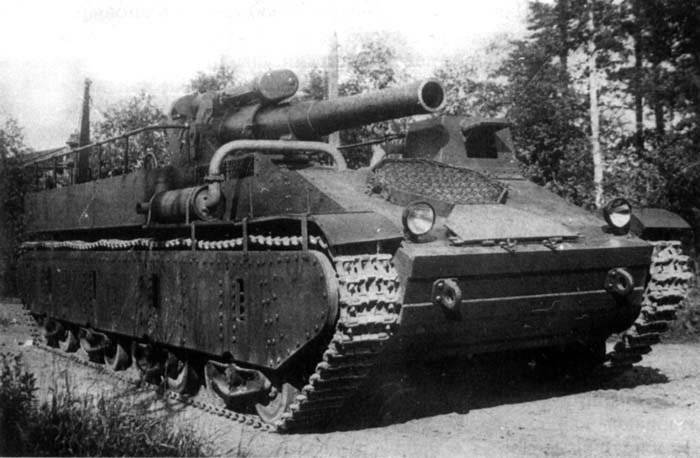
Combat use and service
The first T-35 tanks met the operational and technical requirements that were imposed on the heavy tanks of the Red Army. In addition, the fire power of the T-35 exceeded the power of any tanks in the world. Five machine guns (located in five rotating towers) and three guns provided a massive circular fire in all directions at the same time, which gave certain advantages in the fight against enemy infantry in the depths of his defense. However, this was the reason for the complexity of the design and required an increase in the number of crew members. Traction and dynamic qualities of the tank were insufficient, which especially affected when turning. The combination of these shortcomings did not allow to fully carry out the tasks that were assigned to a heavy tank. A large number of towers was the reason that the commander could not carry out effective fire control. Poor booking was the reason that the tank was vulnerable to artillery, and its low mobility and huge size made it an excellent target.
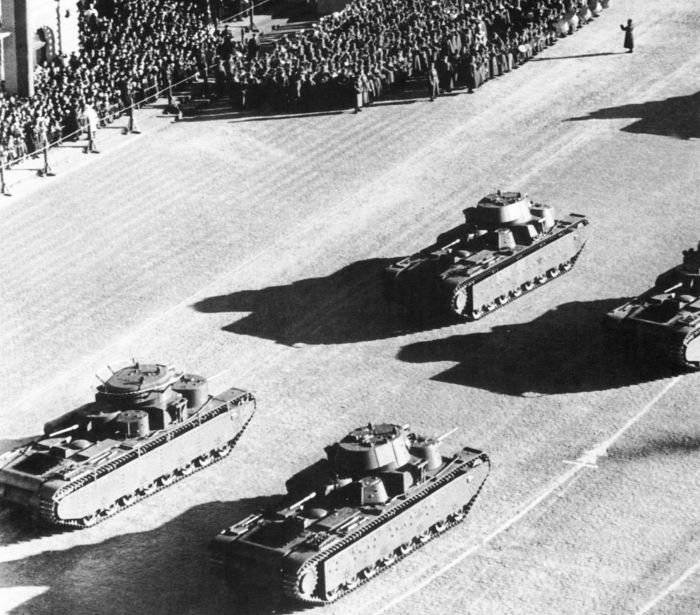
It was clear that a new concept of a heavy tank was needed. Experimental tanks QMS, and T-100 created in the framework of this new concept. The KV tank became the ancestor of the first successful Soviet series of heavy tanks.
Thus, the T-35 to the 1941 year was morally obsolete, but it was not removed from service. As of 22.05.1941, the Red Army had 48 T-35 tanks, which were in service with the sixty-seventh and sixty-eighth tank regiments of the thirty-fourth tank division of the Kiev Special Military District. Others were at the disposal of test sites and military schools. All T-35, which were at the disposal of the 34-th tank division, were located in the area of Rava-Russkaya by the beginning of the war and were almost immediately lost. At the same time, all 7 machines were lost directly in the battles, 6 was under repair at the time of the outbreak of hostilities, and other 35s failed due to malfunctions, broke down during the march and were destroyed or abandoned by crews. The last use of two T-35 - in the battle of Moscow. Interestingly, there are great photos of abandoned T-35 tanks that were made by the Germans - simple soldiers and panzerwa tankers liked to be photographed around the “miracle of hostile technology”.
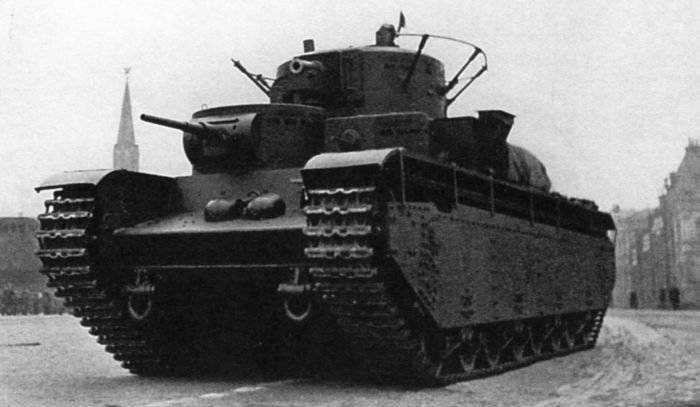
In the first weeks of the Second World War, the T-35 tank, fully operational and probably abandoned due to a fuel shortage, was sent by the Germans to the Kummersdorf test site, where it was carefully studied by German engineers. At the same time, they noted that there were difficulties with transporting the car - the tank did not fit into the railway envelope, and switching levers is an incredibly difficult and exhausting business. The further fate of this tank is unknown. The last case of the combat use of the T-35 tank was the use by the Germans at the end of April of the 1945 of one trophy T-35 during the defense of Berlin. This vehicle was transferred from the Zossen test site and incorporated into the fourth company of the eleventh tank regiment. As part of the company he participated in battles around the landfill, where he was soon shot down.
Tank T-35 as a symbol of the power of the Red Army
As already noted, until the beginning of the Second World War, the T-35 tank did not take part in the hostilities. T-35 periodically used in military maneuvers, but the main of the "battlefield" were the squares of Kiev and Moscow. T-35 became a truly visible embodiment of the power of the Red Army. Starting from the 33 year and up to the Second World War, the T-35 tanks took part in all parades. True, the number of tanks participating in the parade was small. For example, on November 7 40, the entire 20 machines were displayed at parades (10 in each city).
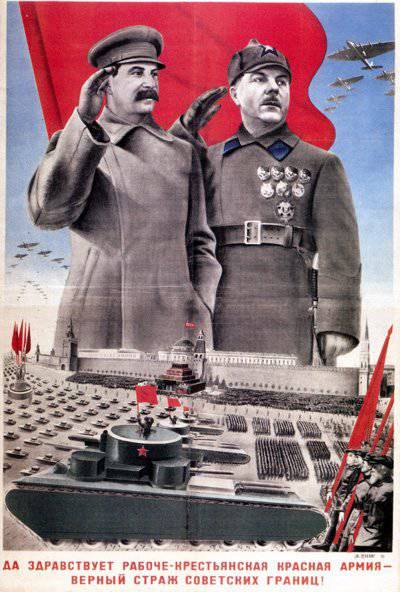
In addition, T-35 depicted on campaign posters. An interesting fact is that the image of the T-35 tank is present on the poster of 43. There was not a single T-35 in the troops at that time, but the “land battleship”, bristling with cannons, continued to carry out a propaganda function, personifying the might of the Red Army.
In addition, a simplified image of the T-35 tank was used in the design of the medal "For Courage".

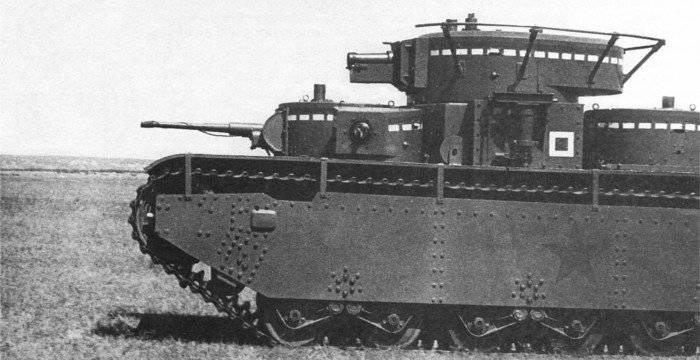
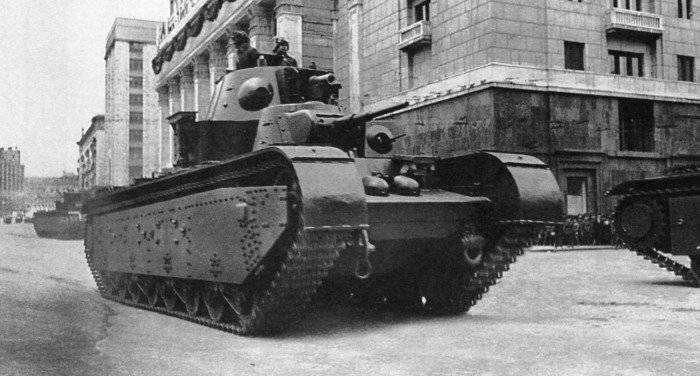
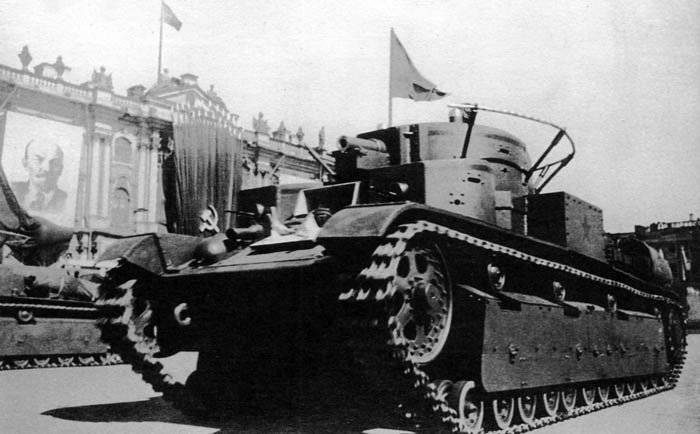
Information